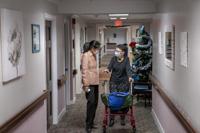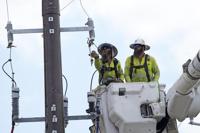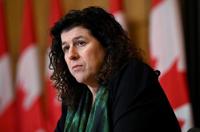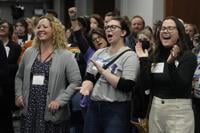NEW YORK (AP) — The federal government will, for the first time, dictate staffing levels at nursing homes, the Biden administration said Friday, responding to systemic problems bared by mass COVID-19 deaths.
While such regulation has been sought for decades by allies of older adults and those with disabilities, the proposed threshold is far lower than many advocates had hoped. It also immediately drew ire from the nursing home industry, which said it amounted to a mandate that couldn't be met.
With criticism expected, a promise made with fanfare in speech had its details revealed as many Americans turned away from the news for a holiday weekend.
“We are working to make sure no nursing home can sacrifice the safety of their residents just to add some dollars to their bottom line,” the president said in
The American Health Care Association, which lobbies for care facilities, called the proposal “unfathomable,” saying it will worsen existing problems and cost homes billions of dollars.
“We hope to convince the administration to never finalize this rule as it is unfounded, unfunded, and unrealistic,” said AHCA's president, Mark Parkinson, the former Democratic governor of Kansas.
The proposed rules, which now enter a public comment period and would take years more to fully take effect, call for staffing equivalent to 3 hours per resident per day, just over half an hour of it coming from registered nurses. The rules also call for facilities to have an RN on staff 24 hours a day, every day.
The average U.S. nursing home already has overall caregiver staffing of about 3.6 hours per resident per day, according to government reports, including RN staffing just above the half-hour mark.
Still, the government insists a majority of the country’s roughly 15,000 nursing homes, which house some 1.2 million people, would have to add staff under the proposed rules.
Chiquita Brooks-LaSure, who heads the Centers for Medicare and Medicaid Services, or CMS, called the move “an important first step.” CMS oversees nursing homes.
A senior White House official, speaking on the condition of anonymity ahead of the announcement, said the Biden administration was open to revisiting the staffing threshold once implemented.
“I would caution anyone who thinks that the status quo — in which there is no federal floor for nursing home staffing — is preferable to the standards we’re proposing,” said Stacy Sanders, an aide to Health Secretary Xavier Becerra. “This standard would raise staffing levels for more than 75% of nursing homes, bringing more nurse aides to the bedside and ensuring every nursing home has a registered nurse on site 24/7.”
The new thresholds are drastically lower than those that had long been eyed by advocates after a recommended an average of 4.1 hours of nursing care per resident daily.
Most U.S. facilities don’t meet that threshold. Many advocates said even it was insufficient, not taking into account quality of life, simply determining the point at which residents could suffer potential harm.
After the Democratic president elevated the issue in his State of the Union speech, advocates were initially elated, expecting the most significant change for residents since the Nursing Home Reform Act of 1987. That changed after a copy of a new CMS-funded study on the subject , claiming there is “no obvious plateau at which quality and safety are maximized.”
Advocates were bereft, saying they felt betrayed by administration officials they thought to be allies. As word of the proposal became public early Friday some were even more blistering.
Richard Mollot, who leads the Long Term Care Community Coalition, called it “completely inadequate” and a blown chance of “a once-in-a-generation opportunity” that “flouts any evidence” of what residents need and fails to make good on the heart of Biden’s promise. He begrudgingly acknowledged the 24/7 RN rule could bring small improvements to the worst facilities, but he otherwise was withering in his criticism.
Calling the move “heartbreaking” and “nauseating,” he said it would do more harm than good, putting a government imprimatur on poorly staffed homes and imperiling wrongful-death lawsuits.
“It is a tremendous dereliction of duty,” he said. “We are continuing to allow nursing homes to warehouse people and to rip the public off.”
Current law , but it leaves nearly all interpretation to states. Thirty-eight states and the District of Columbia have their own staffing regulations. Some are so low that advocates say they’re meaningless, and, across the board, enforcement is often toothless.
The problem has long been apparent to front-line nurse aides — the low-paid, overwhelmingly female and disproportionately minority backbone of facility staffs — , whose call bells go unanswered, whose showers become less frequent and who lie hungry, awaiting help with meals.
The coronavirus pandemic, which claimed more than 167,000 U.S. nursing home residents, brought the greatest attention to poor staffing in history. But, in its wake, many homes .
Across all job types, Bureau of Labor Statistics data shows nursing homes have 218,200 fewer employees than in February 2020, when the first U.S. outbreak of the coronavirus arrived at a nursing home outside Seattle.
AHCA has waged a relentless campaign claiming facilities were teetering, with Medicaid subsidies insufficient, widespread hiring issues and rampant home closures. While there have been scattered closures, the profitability of homes has repeatedly been exposed and critics have argued, if they just paid better, the workers would come.
Katie Smith Sloan, the head of LeadingAge, which represents nonprofit nursing homes, said it was meaningless to create a rule requiring facilities to hire additional staff when the industry was already in a workforce crisis and “there are simply no people to hire.”
“To say that we are disappointed that President Biden chose to move forward with the proposed staffing ratios despite clear evidence against them is an understatement,” she said.
___
This story has been corrected to show the surname of the Long Term Care Community Coalition leader is Mollot, not Mollott, and the health secretary's surname on second reference is Becerra, not Beccera.
___
Sedensky can be reached at msedensky@ap.org and










































